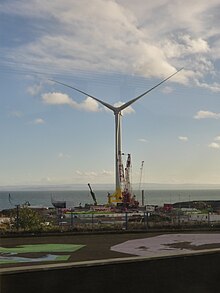Samsung Heavy Industries
| Samsung Heavy Industries Co., Ltd
|
|
|---|---|
| legal form | Corporation |
| founding | 5th August 1974 |
| Seat | Seoul , South Korea |
| Number of employees | 14,383 |
| Branch | Shipbuilding , wind turbine manufacturer |
| Website | www.samsungshi.com |
| As of March 17, 2016 | |

Samsung Heavy Industries (SHI) is a South Korean company headquartered in Seoul . The company, founded in 1974, is a subsidiary of the South Korean conglomerate Samsung and is one of the largest shipyards in South Korea. In addition, wind turbines are manufactured.
history
In addition to shipbuilding, the portfolio also included commercial vehicles (spun off into Samsung Commercial Vehicles ) and passenger cars ( Samsung Motors ) in the 1990s . In 2014 it was merged with Samsung Engineering, which is involved in power plant construction. In addition to building ships and offshore floating platforms for the oil industry, SHI is also active in the energy sector. Among other things, the company manufactures wind turbines . In addition to a portfolio for the onshore sector with 2.3 MW, 2.5 MW and 2.7 MW, Samsung is also developing a 7 MW turbine with a rotor diameter of 171 meters for use in offshore wind farms . The prototype was installed in October 2013 in the Scottish “Energy Park Fife” test field a few meters from the coast.
Like all shipyards in South Korea, Samsung Heavy Industries is also suffering from the global decline in demand. On the one hand, the Chinese shipyards, with their cost advantage, are exerting great pressure on South Korean shipyards; on the other hand, the South Korean shipyards hardly have any cost advantages over shipyards in Japan because of the devaluation of the yen. At the same time, large wage increases have been accepted in the past due to strong protests by the unions. In addition, the South Korean shipyards did not succeed in opening up alternative business areas (such as cruise ships) as did the German shipyards. Incoming orders at Samsung Heavy Industries, like the other South Korean shipyards, fell dramatically, especially from the oil industry. At the end of May 2016, KDB, the state bank of South Korea, approved the company's proposal to implement internal measures. This includes the sale of business areas outside of the core area, capital increases and layoffs of the workforce. With these measures, the company aims to save up to $ 1.3 billion. By 2018, the workforce should be reduced by 30–40% through early retirement and layoffs. The union, meanwhile, voted to strike to protest the planning.
Individual evidence
- ↑ Overview Samsung Heavy Industries , company website. Retrieved March 17, 2016.
- ↑ Overview Samsung Heavy Industries ( Memento of the original from March 18, 2015 in the Internet Archive ) Info: The archive link was inserted automatically and has not yet been checked. Please check the original and archive link according to the instructions and then remove this notice. . Retrieved March 11, 2015.
- ↑ The new offshore generation. Construction progress in the royal class . In: Renewable Energies. Das Magazin , October 17, 2013. Retrieved October 17, 2013.
- ↑ World's largest offshore turbine built . In: Renewable Energies. Das Magazin , October 25, 2013. Retrieved October 25, 2013.
- ↑ Chung Seok-woo: KDB okays Samsung Heavy Industries' self-rescue plan. In: pulsenews.co.kr. pulse, June 2, 2016, accessed June 4, 2016 .
- ^ Park Yong-beom: Samsung Heavy Industries to shed workforce up to 40%. Pulsenews, June 15, 2016, accessed June 15, 2016 .